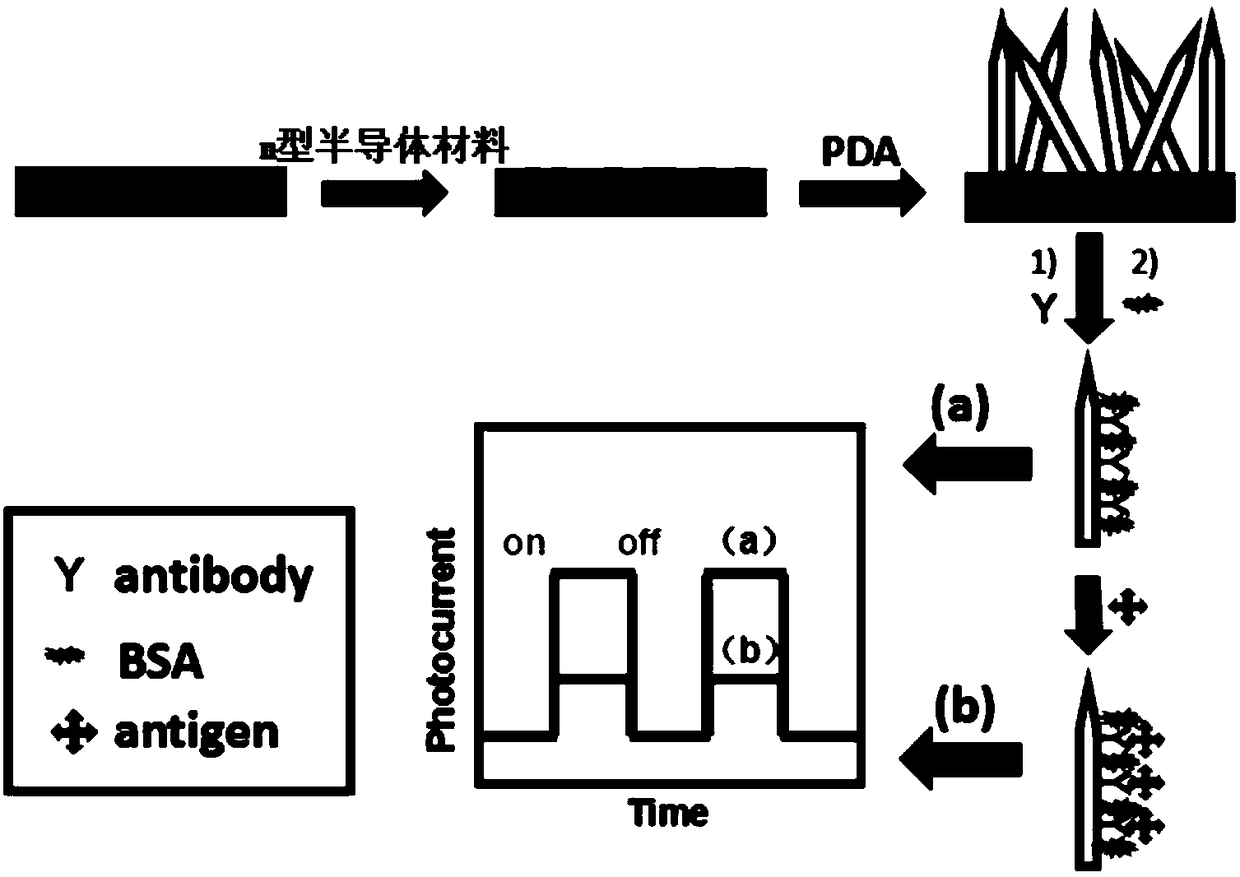Application of polydopamine-modified n-type semiconductor materials in the construction of optoelectronic immunosensors
An n-type semiconductor, immunosensor technology, applied in the field of biosensors, can solve the problems of cumbersome construction steps, poor device stability and repeatability, etc., and achieve increased photocurrent response, simple structure, good specificity and stability. Effect
- Summary
- Abstract
- Description
- Claims
- Application Information
AI Technical Summary
Problems solved by technology
Method used
Image
Examples
Embodiment 1
[0035] Polydopamine modified semiconductor zinc oxide rods to construct photoelectric immunosensors, the specific steps are as follows:
[0036] (1) Grow ZnO nanorods on the FTO glass sheet: first, the conductive surface of the FTO glass sheet after being ultrasonically cleaned by acetone, absolute alcohol, and secondary water in turn leans against the wall of the beaker containing the growth solution, Among them, each cleaning solution was ultrasonically cleaned 3 times, each time for 5 minutes; then, the beaker was placed in a 75°C water bath for 2 hours; finally, the glass sheet was taken out, rinsed with water twice, and then dried with nitrogen to obtain ZnO / FTO electrode, the preparation method of the growth solution is to add 2.97g zinc nitrate hexahydrate, 3mL ammonia water, 1mL ethylenediamine into 100mL secondary water successively;
[0037] (2) Growth of polydopamine film on ZnO / FTO electrode: the ZnO / FTO electrode obtained in step (1) was immersed in the dopamine ...
Embodiment 2
[0044] The PDA / ZnO / FTO electrode prepared in Example 1 was used as the working electrode, the platinum sheet and the saturated calomel electrode were respectively the counter electrode and the reference electrode, 1mM ascorbic acid was added as the electrolyte in 0.1M PBS, the applied voltage was 0V, and the xenon lamp (The power is 500W, the power density is 100mW / cm 2 ) as the light source, record the transient current curve, the obtained results are as follows Figure 5 shown by Figure 5 It can be seen that after 20 dark state-bright state cycles, the decay of the photocurrent is less than 5%, indicating that the electrode has good stability. Among them, the electron transfer principle of the polydopamine-zinc oxide nanorod electrode on the PDA / ZnO / FTO electrode in the ascorbic acid solution is as follows: Image 6 shown by Image 6 It can be seen that under light conditions, the conjugated macrocyclic structure in polydopamine effectively absorbs photon energy, and the...
Embodiment 3
[0046] 1. The PDA / ZnO / FTO electrode prepared in Example 1 is used as the working electrode, the platinum sheet and the saturated calomel electrode are respectively the counter electrode and the reference electrode, 1mM ascorbic acid is added as the electrolyte in 0.1M PBS, and the applied voltage is 0V , xenon lamp (power is 500W, power density is 100mW / cm 2 ) as the light source, record the transient current curve, the result is as follows Figure 7 (a);
[0047] 2. The goat anti-mouse IgG monoclonal antibody / PDA / ZnO / FTO electrode prepared in Example 1 is used as the working electrode, the platinum sheet and the saturated calomel electrode are respectively the counter electrode and the reference electrode, and 0.1M PBS is added 1mM ascorbic acid is used as the electrolyte, the applied voltage is 0V, the xenon lamp (the power is 500W, the power density is 100mW / cm 2 ) as the light source, record the transient current curve, the result is as follows Figure 7 (b);
[0048] ...
PUM
| Property | Measurement | Unit |
|---|---|---|
| concentration | aaaaa | aaaaa |
| concentration | aaaaa | aaaaa |
Abstract
Description
Claims
Application Information
 Login to View More
Login to View More - R&D
- Intellectual Property
- Life Sciences
- Materials
- Tech Scout
- Unparalleled Data Quality
- Higher Quality Content
- 60% Fewer Hallucinations
Browse by: Latest US Patents, China's latest patents, Technical Efficacy Thesaurus, Application Domain, Technology Topic, Popular Technical Reports.
© 2025 PatSnap. All rights reserved.Legal|Privacy policy|Modern Slavery Act Transparency Statement|Sitemap|About US| Contact US: help@patsnap.com



